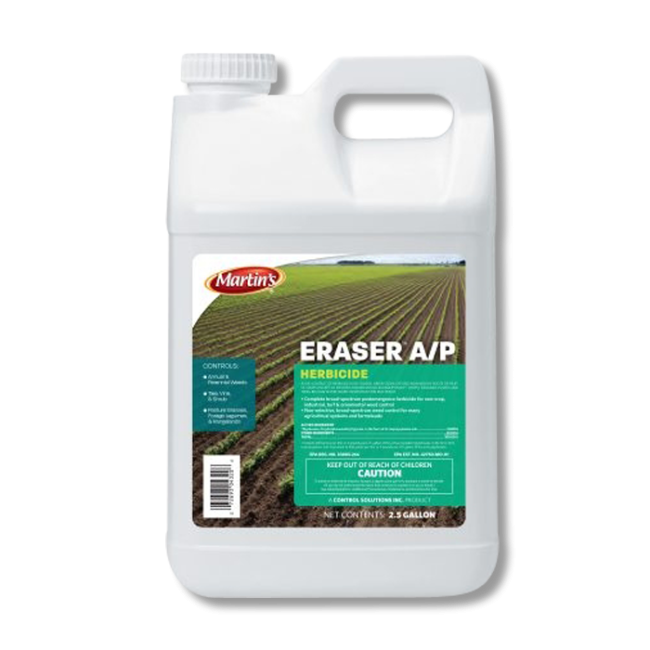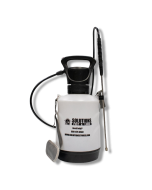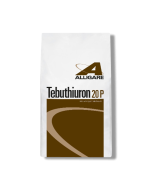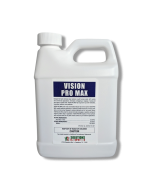Gain access to personalized product screening, the best pricing, rewards, and more!




application2
Martin's Eraser A/P Herbicide
Martin's Eraser A/P Herbicide is a professional non-selective post-emergent herbicide that completely controls annual and perennial weeds, trees, vines, and shrubs on non-crop, vegetable crops, farmsteads, ornamentals, and more.
12/21/25
Martin's Eraser A/P, manufactured by Control Solutions, is a non-selective systemic post-emergent herbicide that delivers broad-spectrum control of various annual and perennial weeds, woody brush, ornamentals, and trees.
This emulsifiable concentrate is meant for spot treatment of invasive weeds in homes and properties, but it is also great for agricultural and industrial sites.
When applied, Martin's Eraser A/P systemically travels down to the plant's root system, with visible yellowing and deterioration occurring within 2 to 4 days for annual or 7 days for perennial weeds.
Tools Needed
You will need a backpack sprayer, hand-pump sprayer, or skid sprayer. A handheld pump sprayer is best for the average residential application.
How to Use
- Step 1: Determine how much Martin's Eraser A/P you will need by measuring the square footage of the treatment area. To do this, measure the treatment areas' length and width in feet, then multiply them together (length X width = square footage). To control annual and perennial weeds with Martin's Eraser A/P, apply between 0.5% and 2% of the product. This means that with one gallon of finished solution, you will mix between 0.64 and 2.56 fl. oz. of Eraser A/P. If you are trying to control woody brush or trees, mix a 5% to 10% solution, so you will need to use between 6.4 and 12.8 fl. oz. of product.
- Step 2: Fill your sprayer with half a gallon of water and add a measured amount of Eraser A/P. Agitate the mixture until the product is fully dispersed, then add the remaining water up to the 1-gallon line. Close your sprayer and shake it to ensure an even distribution. Once the solution is fully mixed, you can add additional products, like a marking dye.
- Step 3: Apply the solution over the plants you wish to treat. Use a coarse spray and be sure to achieve full plant coverage, focusing on the leaves. For the best weed control, apply before seed formation to avoid possible retreatments in the future. Eraser A/P will not treat seeds that germinate after application. Weeds must have emerged to be affected. Retreatment of perennials may be necessary due to regenerating underground parts.
Where to Use
Martin's Eraser A/P is labeled to be used along fences, agricultural areas, driveways, patios, sidewalks, brick and gravel walkways, curbs, around ornamental trees, shrubs, flower beds and plantings, grape vines, next to trees and nut trees, and around buildings to control weeds and unwanted vegetation in preparation for planting ornamentals, trees, shrubs, desert landscapes, and rock gardens.
Apply the product where you see the pesky weeds growing near trees, in your driveway, or in the cracks of your pathway. The product is best used close to the ground and near the weeds that are giving you trouble so as not to affect nearby grass or vegetation. Be careful not to spray desired plants or turfgrass.
When to Use
Use when weeds are small and actively growing. For perennial weeds, the best control is obtained during the late growth stages as the plant approaches maturity. The ideal circumstances for using this product would be during a warm day, as the product is accelerated by warm, sunny weather. Also, make sure to apply when there is no wind outside and the product cannot be translocated to ornamental plants and flowers.
Safety Information
Martin's Eraser A/P is safe to use around children and pets when applied according to the product label instructions. Always wear the proper personal protective equipment (PPE) when handling or applying this product.
Do not allow people or pets into the treated area until the product has dried completely.
Special Considerations
Keep in mind that Martin's Eraser A/P has no residual soil activity. This product must make contact with emerging plant leaves to take effect. Do not use this product to control un-emerged weeds from seed or from underground perennial features like rhizomes.
To help avoid overlap as you apply the product, we recommend you use a marking dye like Vision Blue or Vision Pro Max. These products are temporary colorants used to indicate where you have sprayed. When mixed into your spray solution, your application will leave turf a deep, blue color, reminding you where you have sprayed so you know not to apply there again. Keep in mind that using a dye or colorant may reduce the product's effectiveness.
Martin's Eraser A/P is an effective non-selective post-emergent herbicide that will kill treated weeds in days. Most active infestations cannot be controlled through the use of one product. For the best weed control, you will need to support your lawn's health with the right fertilizer, and you may also need a pre-emergent herbicide to prevent weed growth for the following seasons.
| Restricted Use | No |
|---|---|
| Shipping Restrictions | AK |
| Availability | Online |
| Signal Word | CAUTION |
| Keith's Pro Tip | "Be careful when spraying Martin's Eraser A/P around desired plants. A neat tip is to use a plastic container or cardboard to shield the vegetation you want to protect when spraying." |
| Target Pests Multi | Alfalfa, Alligatorweed, Anise Fennel, Annual Bluegrass, Annual Fleabane, Annual Sowthistle, Artichoke Thistle, Barnyardgrass, Bentgrass, Bermudagrass, Bittercress, Black Nightshade, Blue Mustard, Bracken Fern, Bristly Foxtail, Broadleaf Signalgrass, Browntop Panicum, Bulbous Bluegrass, Burcucumber, Buttercup, Canada Thistle, Carolina Geranium, Carpetweed, Cattail, Cereal Rye, Cheat, Cheatgrass, Chervil, Chickweed, Cocklebur, Cogongrass, Common Groundsel, Common Milkweed, Common Mullein, Common Pokeweed, Common Ragweed, Corn Speedwell, Corn Volunteer, Coyote Brush, Crabgrass, Crowfootgrass, Curly Dock, Cutleaf Evening Primrose, Dallisgrass, Dandelion, Devils Claw, Downy Brome, Dwarfdandelion, Eastern Mannagrass, Eclipta, Fall Panicum, False Dandelion, Fescue, Fiddleneck, Field Bindweed, Field Pennycress, Field Sandbur, Filaree, Fivehook Bassia, Florida Beggarweed, Florida Pusley, Giant Foxtail, Giant Ragweed, Goatweed, Goosegrass, Grain Sorghum, Groundcherry, Guineagrass, Hairy Fleabane, Hairy Nightshade, Hemp Dogbane, Hemp Sesbania, Henbit, Honeysuckle, Horsenettle, Horseradish, Horseweed/Marestail, Iceplant, Itchgrass, Japanese Brome, Jerusalem Artichoke, Jimsonweed, Johnsongrass, Jointed Goatgrass, Junglerice, Kentucky Bluegrass, Kikuyugrass, Knapweed, Knotgrass, Knotweed, Kochia, Kudzu, Ladysthumb, Lambsquarters, Lantana, Leafy Spurge, Little Barley, London Rocket, Longspine Sandbur, Mayweed, Multiflora Rose, Napier Grass, Oats, Orchardgrass, Overwintered Wheat, Palmer Pigweed, Pampasgrass, Paragrass, Pennsylvania Smartweed, Perennial Ryegrass, Perennial Sowthistle, Phragmites, Pigweed, Plains Coreopsis, Poison Hemlock, Poison Ivy, Poison Oak, Prickly Lettuce, Prostrate Spurge, Purple Ammannia, Purple Nutsedge, Purslane, Purslane Speedwell, Quackgrass, Quaking Aspen, Red Clover, Red Rice, Redvine, Reed Canarygrass, Rough Fleabane, Russian Thistle, Rye Volunteer, Ryegrass, Seedling Johnsongrass, Shattercane, Shepherdspurse, Sicklepod, Silverleaf Nightshade, Smallseed Flaxweed, Smartweed, Spanishneedles, Spotted Spurge, Sprangletop, Spurred Anoda, Stinkgrass, Sunflower, Swamp Smartweed, Swinecress, Tall Fescue, Tansy Mustard, Teaweed, Texas Blueweed, Texas Panicum, Timothy, Torpedograss, Trumpet Creeper, Tumble Mustard, Umbrella Spurry, Vaseygrass, Velvetgrass, Velvetleaf, Virginia Copperleaf, Virginia Creeper, Virginia Pepperweed, Waterhemp, Western Wheatgrass, Wheat, White Clover, Wild Buckwheat, Wild Mustard, Wild Oats, Wild Proso Millet, Wild Sweet Potato, Willow, Wirestem Muhly, Witchgrass, Woolly Cupgrass, Woollyleaf Bursage, Yellow Foxtail, Yellow Rocket, Yellow Starthistle, Yellow_Nutsedge, Alder, American Hornbean, Ash, Barley, Beech, Birch, Bitter Cherry, Black Cherry, Black Gum, Black Locust, Black Oak, Black Sage, Blackberry, Bracken, California Buckwheat, California Sagebrush, Cascara, Catsclaw, Ceanothus, Chamise, Chinese Tallowtree, Dogwood, Eastern Redbud, Elderberry, Elm, Eucalyptus, Florida Holly, French Broom, Gorse, Hasardia, Hawthorn, Hazel, Hickory, Madrone Resprouts, Manzanita, Monkey Flower, Northern Oak, Persimmon, Pin Cherry, Pine, Poison Sumac, Post Oak, Red Maple, Salmonberry, Salt Cedar, Sassafras, Scotch Broom, Smooth Sumac, Sourwood, Southern Red Oak, Southern Waxmyrtle, Sugar Maple, Sweet Gum, Swordfern, Tan Oaks Resprouts, Thimbleberry, Tobacco Tree, Vine Maple, White Oak, White Sage, Winged Sumac, Yellow Poplar |
| Time to Kill | Martin's Eraser A/P works systemically down to the root system of the plant. Visible yellowing and deterioration can occur within 2 to 4 days for annual weeds. Perennial weeds may not see visible effects for 7 days or more. |
| Chemical Type | Herbicide |
| Formulation | Emulsifiable Concentrate (EC) |
| Application Methods | Broadcast Spray, Spot Treatment |
| Product Drawbacks | Martin's Eraser A/P is a kill all herbicide so you will need to be careful when spraying around desired plants. |
| Active Ingredient | Glyphosate, N -(phosophonemethyl) gylcine, in the form of its isopropylamine salt 41% Other 59% |
| Application Equipment | Backpack Sprayer, Hose End Sprayer, Pump Sprayer, Spray Rig |
| Mix Rate | The typical mix rate of Martin's Eraser A/P for a gallon of water varies depending on the spray solution ratio percentage you wish to apply. To achieve a 1.5% ratio you will need to mix 2 oz. in 1 gallon of water to cover 1,000 sq. ft. Check the label for variations. |
| Use Sites | Outdoors |
| Yield | 2.5 gallons of Martin's Eraser A/P can treat up to 160,000 sq. ft. of weeds when using a mix rate of 2 oz. to 1 gallon of water. |
| EPA Registration No. | 53883-266 |
| Shelf Life | Martin's Eraser A/P will last for up to 1 to 2 years when stored according to the product label. Store Eraser AP in the original container in a cool, dry storage area. |
| Comparable Products | Glyphosate 4 Weed Killer |
| Children or pets? | No |
| Property Characteristics | None |
| Availability | Online |
| Restricted Use | No |
| Brand | CSI |
| Keith's Pro Tips | "Be careful when spraying Martin's Eraser A/P around desired plants. A neat tip is to use a plastic container or cardboard to shield the vegetation you want to protect when spraying." |
| Product Drawbacks | Martin's Eraser A/P is a kill all herbicide so you will need to be careful when spraying around desired plants. |
| Target Pests | Alder, Alfalfa, Alligatorweed, American Hornbeam, Anisse, Annual Bluegrass, Annual Fleabane, Annual Sowthistle, Annual Spurge, Artichoke Thistle, Ash, Bahiagrass, Barley, Barnyardgrass, Bearclover, Beech, Bentgrass, Bermudagrass, Birch, Bitter Cherry, Bittercress, Black Cherry, Black Locust, Black Nightshade, Blackberry, Blackgum, Blue Mustard, Bracken, Brackenfern, Broadleaf Signalgrass, Browntop Panicum, Bulbous Bluegrass, Buttercup, California Buckwheat, Canada Thistle, Carolina Foxtail, Carolina Geranium, Cascara, Casterbean, Catsclaw, Cattail, Ceanothus, Chamise, Cheatgrass, Cheeseweed, Chervil, Chickweed, Chineese Tallow Tree, Cocklebur, Cogongrass, Common Groundsel, Common Milkweed, Common Mullein, Common Purslane, Common Ragweed, Corn, Corn Speedwell, Coyote Brush, Crabgrass, Curly Dock, Dallisgrass, Dandelion, Deerweed, Dogwood, Downy Brome, Dwarf Dandelion, Eastern Mannagrass, Eclipta, Elderberry, Elm, Eucalyptus, European Beachgrass, Fall Panicum, False Dandelion, Fescue, Fiddleneck, Field Bindweed, Field Pennycress, Field Sandbur, Filaree, Fivehook Bassia, Florida Pusley, Foxtail, French Broom, German Ivy, Giant Ragweed, Giant Reed, Goosegrass, Grain Sorghum, Grose, Guineagrass, Hairy Fleabane, Hasardia, Hawthorn, Hazel, Hemp Dogbane, Hemp Sesbania, Henbit, Hickory, Honeysuckle, Hophombean Copperleaf, Horsenettle, HorseRadish, Horseweed, Iceplant, Itchgrass, Japanese Brome, Jerusalem Artichoke, Johnsongrass, Jointed Goatgrass, Junglerice, Kentucky Bluegrass, Kikuyugrass, Knapweed, Knotweed, Kochia, Kudzu, Ladysthumb Smartweed, Lamb's Quarters, Lantana, Laurel Sumac, Leafy Spurge, Lespedeza, Little Barley, London Rocket, Madrone Resprouts, Manzanita, Marestail, Mayweed, Medusahead, Morning Glory, Napiergrass, Oats, Orchardgrass, Pampasgrass, Pennsylvania Smartweed, Perennial Pepperweed, Perennial Ryegrass, Phragmites, Pigweed, Pin Cherry, Pin Oak Northern Oak, Plains, Poison Hemlock, Poison Ivy, Poison Oak, Poison Sumac, Prickley Sida, Prickly Lettuce, Prostrate Spurge, Puncturevine, Purple Nutsedge, Purslane Speedwell, Quackgrass, Quaking Aspen, Red Apple, Red Clover, Red Rice, Redvine, Reed Canarygrass, Rough Fleabane, Russian Thistle, Rye, Ryegrass, Scotch Broom, Scrub Oak, Seedling Johnsongrass, Shattercane, Shepherd's Purse, Sicklepod, Silverleaf Nightshade, Smallseed Falseflax, Smooth Brome, Smooth Sumac, Sourwood, Southern Maxmyrtle, Southern Red Oak, Spanishneedles, Spotted Spurge, Sprangletop, Spurred Anoda, Stinkgrass, Sugar Maple, Sugarbush Sumac, Sunflower, Swamp Smartweed, Sweetgum, Swordfern, Tall Fescue, Tan Oak Resprouts, Tansy Mustard, Teaweed, Texas Blueweed, Texas Panicum, Thimbleberry, Tickseed Coreopsis, Timothy, Torpedograss, Toyon, Tree Tobacco, Trumpetcreeper, Tumble Mustard, Umbrella Spurry, Vaseygrass, Velvet Leaf, Velvetgrass, Virginia Copperleaf, Virginia Creeper, Virginia Pepperweed, Water Bermudagrass, Western Wheatgrass, Wheat, White Clover, Wierstem Muhly, Wild Mustard, Wild Oats, Wild Sweet Potato, Willow, Winged Sumac, Witchgrass, Woolly Cupgrass, Woolly Leaf Bursage, Yellow Nutsedge, Yellow Rocket, Yellow Starthistle, and Yerbasenta. |
| Application Equipment | Backpack Sprayer, Hose End Sprayer, Pump Sprayer, Spray Rig |
| Application Methods | Broadcast Spray, Spot Treatment |
| Active Ingredient | Glyphosate, N -(phosophonemethyl) gylcine, in the form of its isopropylamine salt 41% Other 59% |
| Product Type | Herbicide |
| Formulation | Emulsifiable Concentrate (EC) |
| Application Rate | The typical mix rate of Martin's Eraser A/P for a gallon of water varies depending on the spray solution ratio percentage you wish to apply. To achieve a 1.5% ratio you will need to mix 2 oz. in 1 gallon of water to cover 1,000 sq. ft. Check the label for variations. |
| Shelf Life | Martin's Eraser A/P will last for up to 1 to 2 years when stored according to the product label. Store Eraser AP in the original container in a cool, dry storage area. |
| Yield | 2.5 gallons of Martin's Eraser A/P can treat up to 160,000 sq. ft. of weeds when using a mix rate of 2 oz. to 1 gallon of water. |
| Use Sites | Outdoors |
| Time to Kill | Martin's Eraser A/P works systemically down to the root system of the plant. Visible yellowing and deterioration can occur within 2 to 4 days for annual weeds. Perennial weeds may not see visible effects for 7 days or more. |
| Comparable Products | Glyphosate 4 Weed Killer |
| Use Caution With | Bentgrass, Bermudagrass, Kentucky Bluegrass, Fescue, Fine, Fescue, Tall, Kikuyugrass, Ryegrass, St Augustine, Zoysiagrass |
| Incompatible Home Siding | Brick, Hardie Plank, Stone Veneer, Stucco, Wood, Vinyl |
| EPA Registration # | 53883-266 |
*Price does not include freight. We guarantee our rate plus shipping will be less than anyone else's price.










